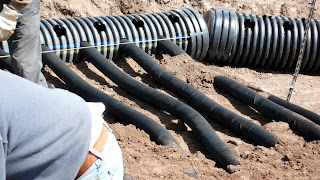



The top left picture shows me looking over the second half of the soil climate battery being put in. The first layer of tubes has been put in and two layers remain. The other photos show more examples of the climate battery as well as display the importance of community in low-budget, high maintenance projects. In the last photo Jerome decided we were done with doing dishes so we ate our sandwiches off comfrey and banana leafs from the greenhouse.
The Soil climate battery was being put in for a forty foot growing dome that is being put in at a local high school. The school provides agriculture classes and will be using the produce. This is also the site of the two acre CSA Farm School. The soil climate battery is a low energy heating system that is used in all of Jerome's Greenhouses. Basically tubes are connected in layers to tunnels with output and input tunnels at each end. There are fans being run off solar panels at the ends of each tunnel. The fans on one side suck down hot air in the day, where the heat is stored in the soil. At night the fans are set to go so that the hot air is released back out into the greenhouse. This keeps the soil at a moderate temperature and helps prevent frost. It is also extremely low energy when compared to conventional greenhouse heating and cooling systems.
I was excited to be involved with this project because I had been studying this heating system, but was unsure how the installation took place. It was encouraging to see how simple and cheap the whole system is.
-speaking of comfrey leaves, I started making batches of my own comfrey compose tea to use as fertilizer. There is a lot of quack grass coming up everywhere and I just learned that this 'weed' can make a great compost tea for fertilizer as well.


